Key takeaways:
- Organic wine production emphasizes sustainability and biodiversity, enhancing grape quality and flavor profiles.
- Temperature control, nutrient availability, and sanitation are crucial for successful fermentation, affecting flavor and stability.
- Implementing techniques like staggered nutrient additions and experimenting with yeast strains can significantly improve fermentation outcomes.
- Monitoring fermentation through gravity readings, aroma detection, and visual observations ensures the desired wine characteristics are achieved.

Understanding organic wine production
Organic wine production is a fascinating journey that transcends just the science of winemaking. It asks for a deep respect for nature and an understanding that the quality of grapes comes from healthy soils and ecosystems. I remember walking through a vineyard and feeling the energy of the earth beneath my feet; it was then that I truly grasped how vital organic practices are for producing exquisite wines.
Choosing organic methods means embracing a philosophy that prioritizes sustainability over convenience. This not only affects the choice of pesticide and fertilizer, which must be natural, but also influences the overall flavor profiles of the wine. Have you ever experienced the difference in taste between a conventional wine and an organic one? The latter often offers a cleaner, more vibrant flavor—one that captures the essence of its terroir.
Moreover, organic wine production is not just about the absence of chemicals; it’s about fostering biodiversity. I once visited a vineyard that had integrated a variety of plants to support beneficial insects. The winemaker shared how this approach not only improved grape quality but also created a thriving ecosystem. It’s a reminder that when we align with nature, both our wines and our planet benefit tremendously.
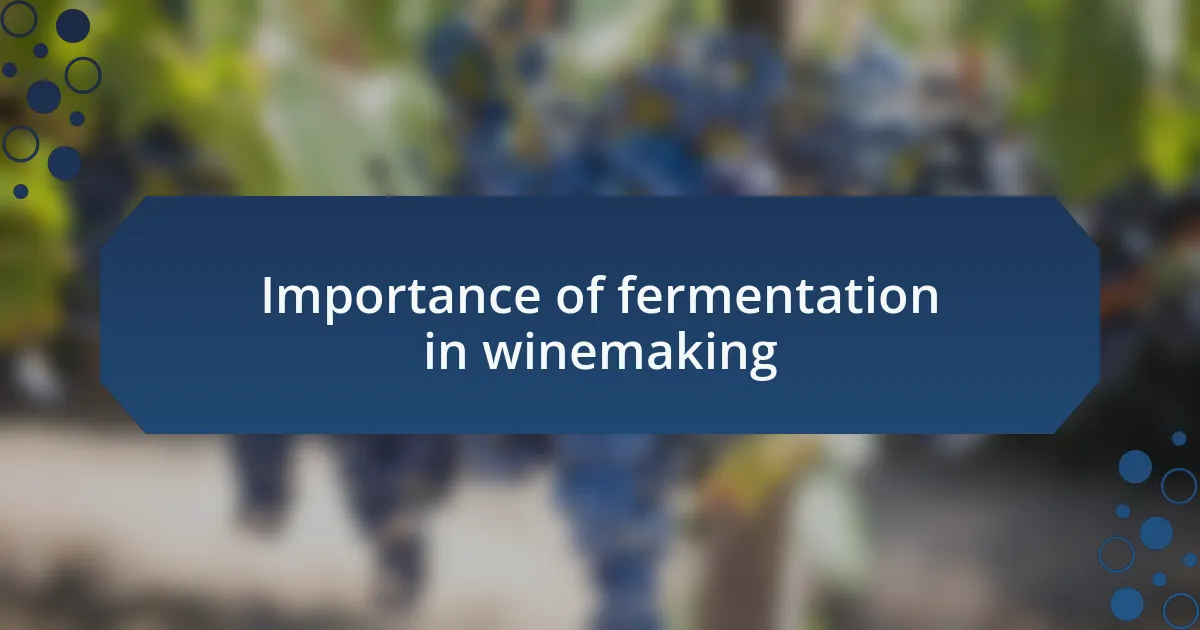
Importance of fermentation in winemaking
Fermentation is the heart of winemaking, transforming sugar from grapes into alcohol. I vividly remember the first time I witnessed this magical process; the bubbling of the must, the aroma of yeasts working their magic, and that unmistakable sense of anticipation created a connection to the wine I was about to craft. Without fermentation, we would be left with plain grape juice, stripped of the complex flavors and aromas that define a good wine.
This stage is also crucial for developing the wine’s character. Different strains of yeast can impart distinct notes, making one wine unique from another. I once experimented with several yeast varieties during a small batch production; it was fascinating to compare the results. Have you ever tasted a wine that completely astonished you? That could well be the result of careful yeast selection, emphasizing the profound impact fermentation has on the overall profile.
Beyond flavor, fermentation plays a vital role in the stability and preservation of the wine. The process naturally produces alcohol and carbon dioxide, which can help inhibit spoilage organisms. I distinctly recall a vintage that went awry because the fermentation was incomplete, resulting in off-flavors that tainted the entire batch. It drove home the lesson that mastering fermentation is essential not only for quality but also for ensuring that the wine reaches its full potential while remaining enjoyable.

Key factors influencing fermentation
When it comes to fermentation, temperature is a crucial element. I once had a challenging vintage where fluctuating temperatures during fermentation led to an unpredictable outcome. You could literally taste the struggle in the final product – a reminder that maintaining a consistent environment is essential for the yeast to thrive and produce desired flavors. Have you ever wondered why some wines feel warmer on the palate? It often comes down to how well the fermentation temperature was controlled.
Another key factor is the nutrient availability in the must. I remember an early attempt at winemaking where I neglected to add nutrients, thinking that the natural sugars would be enough. The yeast struggled, and while the wine still had its moments, it lacked the vibrancy and complexity I had hoped for. It taught me that providing sufficient nutrients not only supports a healthy fermentation but also enhances the final flavor profile of the wine. Could that be the missing link in some of your past batches?
Lastly, sanitation plays an indispensable role in the fermentation process. There was this one instance where I got a bit too relaxed about cleaning my fermentation equipment. The batch turned out infected, and the entire effort was ruined. The emotional toll of watching the hard work go down the drain was intense. It’s a clear lesson that even if the other factors are perfect, neglecting sanitation can compromise everything. How do you ensure your environment is clean and conducive to fermentation? It’s definitely worth developing a routine that leaves no room for error.
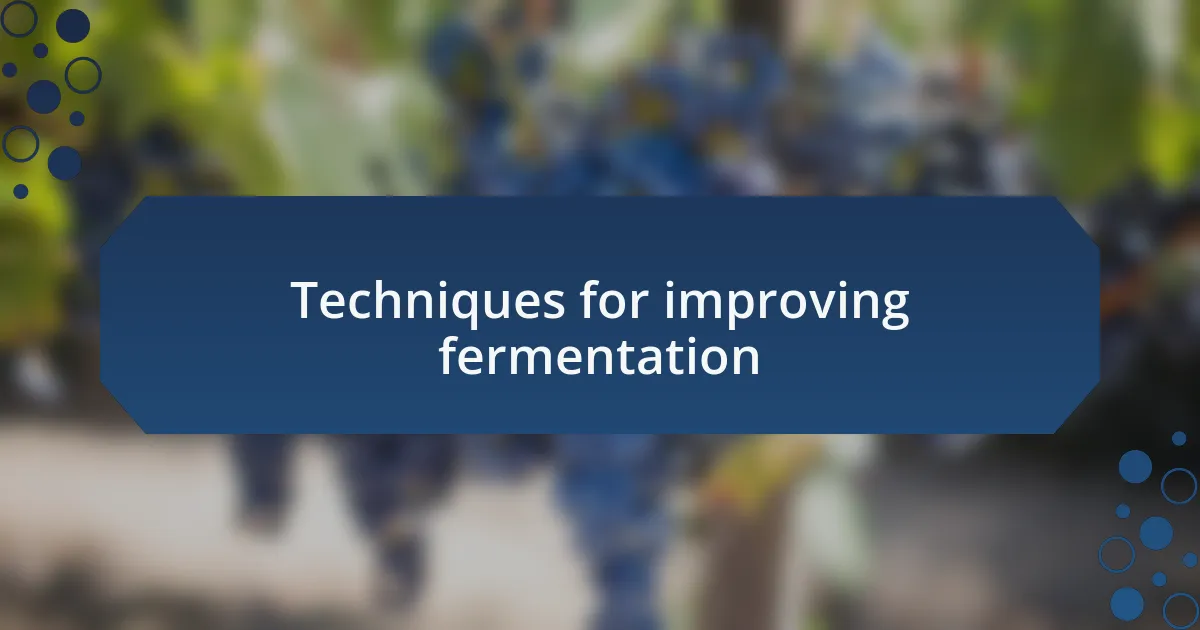
Techniques for improving fermentation
One technique I’ve found invaluable for improving fermentation is the use of temperature control systems. In a particularly hot season, I installed a cooling system for my fermentation vessels, and the difference was night and day. I remember sampling the wine from that vintage, and it felt as though the flavors were dancing—each note distinct and vibrant. It really made me think: how often do we underestimate the power of temperature in fine-tuning our creations?
Another approach I’ve embraced is the practice of staggered nutrient additions. Instead of dumping all the nutrients in at once, I implement a schedule that aligns with the yeast’s needs throughout fermentation. This method reminds me of nurturing a plant; just as you wouldn’t drown a seedling with water, the same applies here. It’s fascinating to observe how the fermentation progresses more smoothly and develops richer flavors over time. Have you considered how your timing might be affecting your fermentation outcomes?
Lastly, I’ve learned the significance of experimenting with different yeast strains. Each strain brings its own personality to the fermentation process, and choosing the right one can transform the potential of your wine. There was this one time I switched to a wild yeast for a small batch, and the complexity of flavors was unlike anything I’d produced before. It left me pondering: what new experiences could you unlock by stepping outside your usual choices? Embracing this technique has opened new avenues for creativity in my winemaking journey.
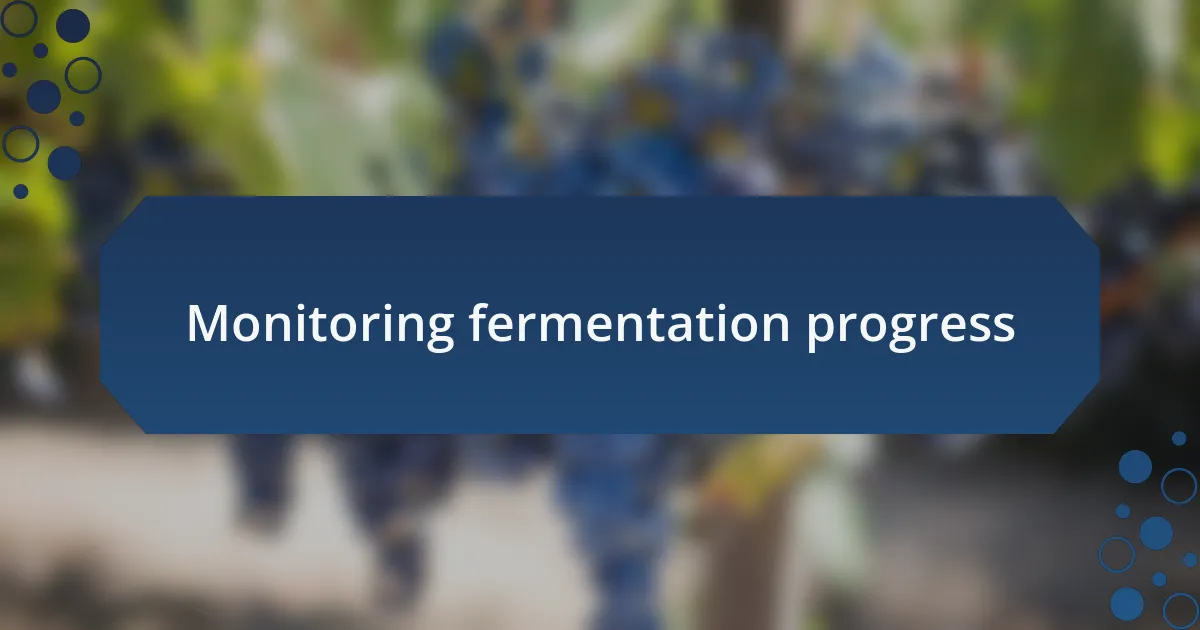
Monitoring fermentation progress
Monitoring fermentation progress is crucial for ensuring that the wine develops the desired characteristics. I often find myself taking regular gravity readings with a hydrometer to track the sugars as they convert into alcohol. Seeing those numbers drop gives me such a satisfying sense of accomplishment; it feels like witnessing the transformation of potential into something beautiful.
I also pay close attention to the aroma that wafts from the fermentation vessel. One year, during a particularly aromatic fermentation, the scent of fresh apples filled my cellar, and I couldn’t help but feel excited about the final product. Isn’t it fascinating how our senses can guide us in this intricate process? Engaging with the aromas can often be an indicator of how things are progressing, alerting me to any potential issues before they escalate.
Visual observations play a significant role too. I remember the first time I saw a vigorous fermentation: bubbles rising, foam forming, and that lively surface activity made me feel like I was witnessing a natural celebration. How often do we take the time to truly reflect on these signs? By observing color changes and sediment formation, I can gauge the vitality of the yeast and adjust my approach as needed, ensuring that each batch aligns with my vision.
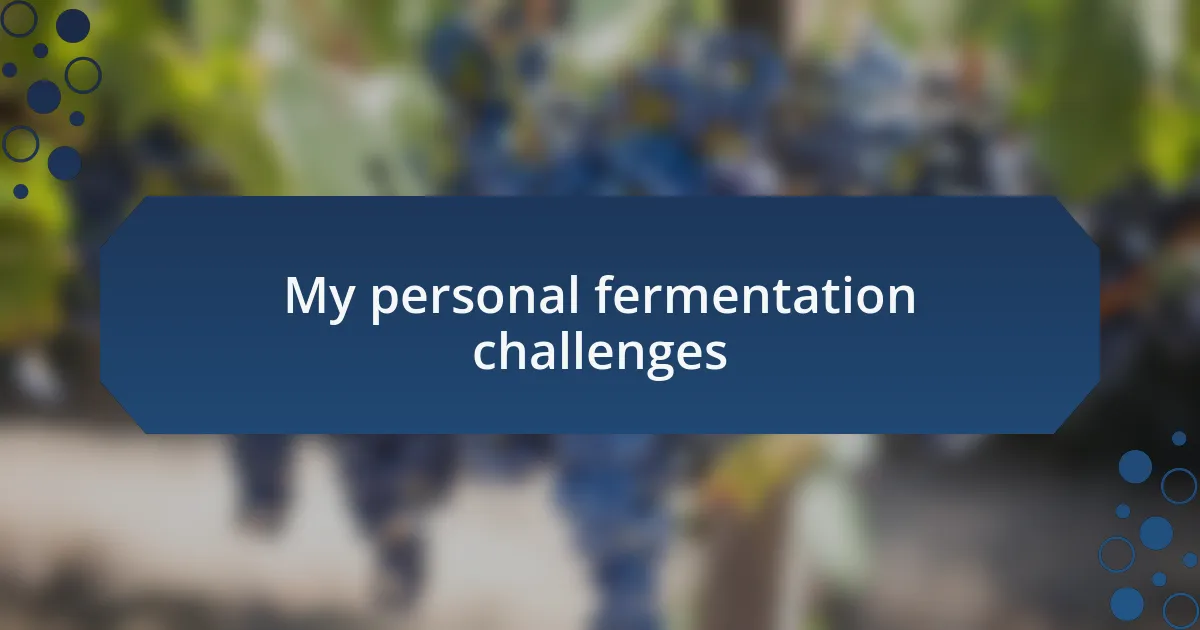
My personal fermentation challenges
There have been times when my fermentation didn’t go as planned, and I’d often wonder, “What went wrong?” One season, I faced a stubborn stuck fermentation. After countless attempts to revive it with nutrient additions, I realized that poor temperature control had played a significant role. It left me feeling frustrated, but ultimately, it taught me the importance of maintaining a stable environment for my yeast.
Another challenge was managing my expectations. I remember a batch that I thought would produce an exceptional wine based on its initial aromas and activity. Yet, as fermentation progressed, I sensed that something wasn’t right. The final product was surprisingly flat, and I couldn’t shake off the disappointment. I learned to embrace each experience, even the disappointing ones, as opportunities for growth and learning.
Sometimes, I question my equipment’s reliability, especially during critical fermentation stages. One year, after investing in a new fermentation vessel, I was confident it would enhance my process. However, it leaked during the first batch, causing a mix of panic and a mess in my cellar. It was a tough lesson; the tools we use need as much attention as the ingredients themselves. How do I ensure my equipment can support my fermentation goals in the future? It’s a constant journey of testing, learning, and adapting.
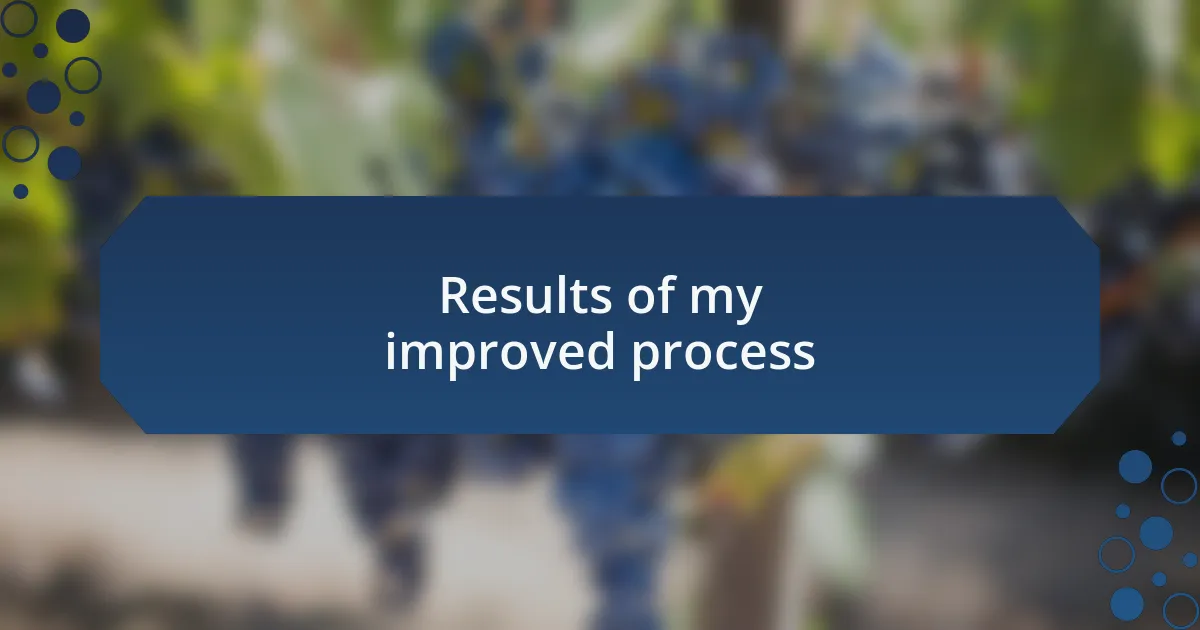
Results of my improved process
After implementing my improved fermentation process, I was pleasantly surprised by the vibrant character of my wines. The consistency in temperature control transformed my fermentation results, leading to a more robust flavor profile that I had only dreamed of before. It felt like unlocking a new level in my winemaking journey, where each bottle tasted like a celebration of my hard work.
One memorable experience was bottling a batch that had undergone my refined fermentation techniques. The excitement was palpable when I hosted a tasting with friends, and their reactions were overwhelmingly positive. As I watched them savor each sip, I felt a wave of validation for the changes I made. Have you ever had that moment when your effort pays off in such a delightful way? It’s those little victories that keep my passion alive.
Moreover, the clarity in my wine improved remarkably. Previously, I struggled with hazy bottles that made me question the quality I was producing. Now, the bright, clear appearance reflects the care I’ve invested in every step of the process. It’s rewarding to see that even delicate adjustments can yield such significant results. Isn’t it fascinating how fermentation can combine science and artistry, producing something truly unique with each batch?